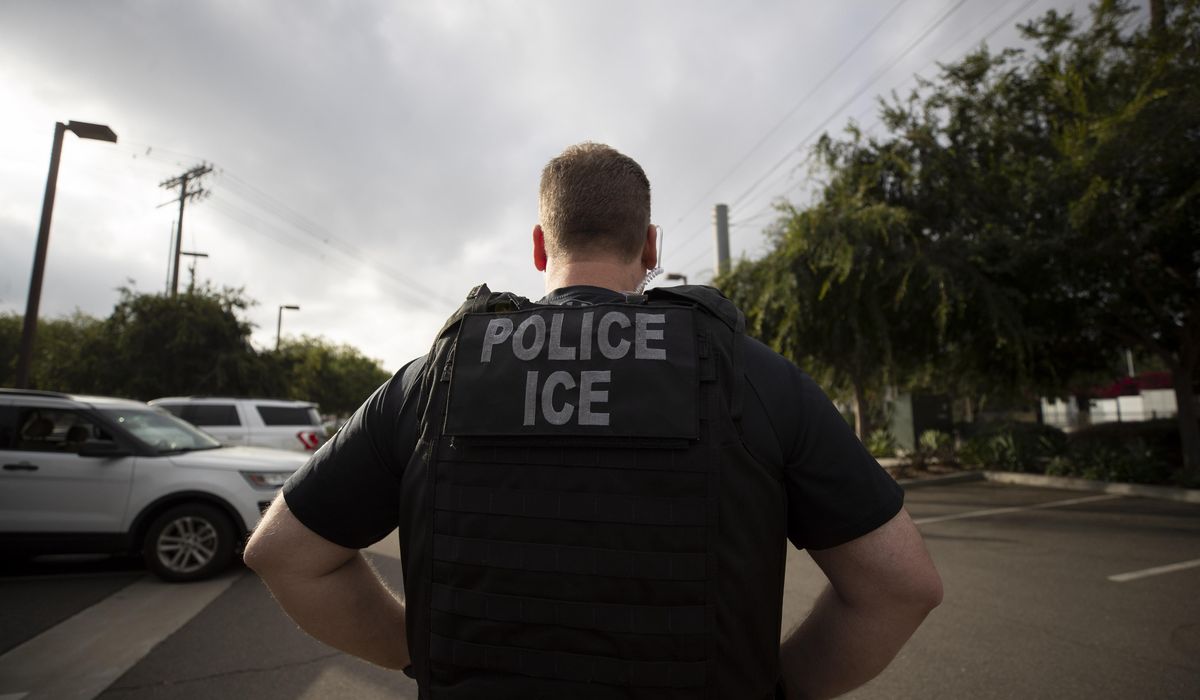
Republicans on the House Oversight Committee are probing the “historically low” rate of arrests of illegal immigrants by ICE, saying it appears the Biden administration, unwilling to abolish ICE outright, is instead paring down the agency through policy memos.
Rep. James Comer of Kentucky, the top Republican on the House Oversight Committee, and Rep. Michael McCloud of Texas, the top Republican on the economic and consumer policy subcommittee, fired off a letter to U.S. Immigration and Customs Enforcement demanding data on why the agency, which has not lost any funding, is arresting and deporting people at a much slower pace than in the past.
In the letter, obtained first by The Washington Times, they tied the decrease to new policies implemented by the Biden team in February and renewed in September that limit the ability of ICE officers to go after illegal immigrants except in the most serious criminal cases, national security threats or recent border crossers.
“As radical, left-wing activists recklessly call to abolish ICE, it appears the Biden Administration is abolishing its mission by memorandum,” the lawmakers wrote in their letter, joined by the other Republicans on the House Oversight Committee.
Mr. Comer and Mr. Cloud asked acting ICE Director Tae Johnson to turn over records on enforcement during President Biden’s tenure, broken down by types of crimes. They also requested the documentary trail that led up to Homeland Security Secretary Alejandro Mayorkas’ key changes this fall.
In a late September memo, Mr. Mayorkas declared that being in the country illegally is no longer sufficient grounds for being arrested or deported. Agents and officers must justify arrests by studying their targets and balancing criminal records against “mitigating” factors like someone’s ties to the country, or hardship they or their family might face if they are deported.
That policy replaced a February memo from Mr. Johnson at ICE that included similar restrictions on enforcement.
Mr. Mayorkas in October released a second policy limiting where enforcement can take place. That memo says agents and officers should not take action around schools, day care centers, bus stops, clinics, parks, churches, social services offices and anywhere children might congregate or illegal immigrants might go to seek assistance.
The Washington Times analyzed those rules for Washington, D.C., and found they put most of the city off-limits for enforcement.
Former ICE officials questioned why, if ICE officers are only going after high-value targets, Mr. Mayorkas would want to limit their ability to get those dangerous persons off the streets.
Homeland Security, in a letter to a number of GOP House lawmakers last month, defended Mr. Mayorkas’ policies, saying ICE doesn’t have the resources to go after every target, so it must be judicious in those it does go after.
“They are guided by the fact that the majority of undocumented noncitizens who could be subject to removal have been contributing members of U.S. communities for years,” wrote Alice Lugo, Mr. Mayorkas’s congressional liaison. “The fact that a noncitizen is a removable citizen should not alone be the basis of an enforcement action against them.”
It’s not clear what a “removable citizen” is. Being deported, or removed, is the civil penalty for those in the country unlawfully, which by definition means they are not citizens.
In addition to the national security and public safety threats, which are judged based on criminal convictions, Ms. Lugo said immigration agents and officers are supposed to be looking for illegal immigrants who jumped the border after Oct. 31, 2020. That roughly coincides with Mr. Biden’s election, and the start of the massive surge of new illegal border jumpers that has plagued the Biden administration.
The Washington Times reported last month that questions have been raised about the process Mr. Mayorkas used to write the new enforcement rules.
The groups he consulted tilted heavily toward immigrant-rights advocacy and were light on pro-enforcement voices.
And some of the enforcement groups that officials said were consulted dispute that characterization. They said their communications with Mr. Mayorkas and his team didn’t constitute outreach, from their point of view.
The new enforcement rules are already facing a legal challenge in a federal court in Texas, with a trial scheduled in the coming weeks.
Texas and Louisiana, which are leading the lawsuit, filed their witness list this week, proposing to call former ICE Director Thomas Homan and Jason Clark, chief of staff at Texas’s Department of Criminal Justice.
According to data the federal government has submitted in that case, under the February enforcement rules ICE averaged about one arrest every two months for each deportation officer on staff. That’s just 25% of what the agency averaged in the Trump years, and about 12% of the average during peak Obama years.
While overall arrests are down, ICE says the number of aggravated felons nabbed is up. During the period of study, the number went from 3,575 in 2020 to 6,046 in 2021.
Homeland Security says that is evidence the new rules are working to prod officers to go after high-value targets.




